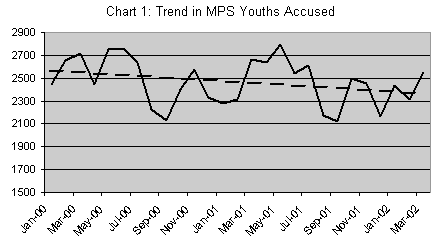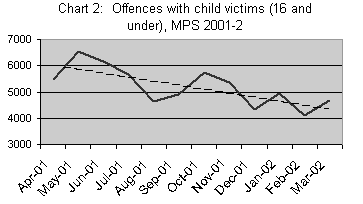Contents
Report 10 of the 19 Sep 02 meeting of the Planning, Performance & Review Committee and discusses the youth objectives that have been set within the MPS Policing Plan.
Warning: This is archived material and may be out of date. The Metropolitan Police Authority has been replaced by the Mayor's Office for Policing and Crime (MOPC).
See the MOPC website for further information.
Proposals for youth targets 2002/03
Report: 10
Date: 19 September 2002
By: Commissioner
Summary
This report provides details of proposed revised measures and targets to be used to assess the achievement of the youth objectives that have been set within the MPS Policing Plan in support of the priority ‘to tackle youth crime’.
A. Recommendation
That the Committee decide on the options provided for the measures and targets to be set for Objectives 12 and 13.
B. Supporting information
1. The MPS policing plan for 2002/3 proposed that targets in support of the priority ‘to tackle youth offending’ should be set against the following objectives and targets:
Objective 12
To improve the diversion of youths away from crime, through enhanced multi-agency activity
| Measure | Target |
|---|---|
| Known youth offending per 1,000 population | Reduction targets will be set once baselines have been established |
| Number of offences with child victims (under 17) |
Objective 13
To reduce re-offending by Persistent Young Offenders (PYOs)
| Measure | Target |
|---|---|
| Persistent young offenders re-offending rate | Awaits baselining |
| Percentage of PYOs dealt with from arrest to charge in two days | 70% |
| Percentage of PYOs dealt with from charge to first court listing in seven days | 71% |
| Percentage of PYOs dealt with from charge to sentence in 71 days (national target) | Awaits baselining |
Issues
2. A number of problems with the proposed measures and targets have emerged. These are:
- The data with regards to known offending and reoffending rates are collated by the Youth Justice Board (YJB). As part of the baselining exercise its quality has been assessed. It is now clear that existing information supplied by YOTs is not sufficiently robust to form the basis of an MPA measure. In addition, whilst the YJB had expected to be able to provide data quarterly and no more than a quarter in arrears, in fact January to March 2002 data is not yet available. Therefore the available data is not adequate or sufficiently up to date to use as a performance measure.
- The PYO timeliness emphasis is beginning to lose relevance to national targets given the Home Office change of focus to persistent offenders, which is expected to be announced in the autumn. · Concerns have been raised that attempts to reduce the number of known youth offenders conflicts with targets to increase judicial disposal rates.
- Concerns have been raised that the intention to reduce the number of child victims conflicts with the stationing of police officers in schools. At the time the plan was drafted there were no firm plans to station police officers in schools.
- It is possible to reduce apparent offending rates by simply not arresting youths and therefore any targets around offending rates could have perverse effects.
- The impact of diversionary activity is long term and therefore one-year targets may not be suitable.
3. For both objectives two options are given, the first retaining the policing plan measures and targets as far as possible, and an alternative option revising the youth section more radically.
4. The discussion of measures and targets is given below:
Objective 12
To improve the diversion of youths
5. Known youth offending rates. The YJB data had been preferred to CRIS data as it showed the number of known offenders being dealt with by each Youth Offending Team (YOT), as YOTs deal with offenders resident on their borough. This information, as noted above, is of insufficient quality and timeliness for use as a performance indicator. Therefore CRIS ‘youth accused’ data is proposed as a proxy; this is a count of police case disposals of arrested persons in each borough, rather than a count of resident offenders being dealt with by YOTs and therefore is not suitable for indexing per 1,000 population.

6. Youth accused totals fell by 0.7% in 2001/02 compared with the previous financial year. This is despite increases in total accused and total judicial disposals. The number of youths accused has fallen 17%, comparing April-June 2001/02 with the same three months the previous year, again this is despite a 5% increase in judicial disposals and a 3% increase in total accused. Therefore there is no evidence that increases in judicial disposal rates have artificially increased the numbers of youths accused – as the main influence on judicial disposal numbers (not rates) is offence levels, any successful targeted operation to reduce crime will reduce future judicial disposals and hence accused as well.
7. Taking the long-term trend (January 2000 to March 2002, see chart 1), the trend is for a decrease of 7.7 youth accused per month, which equates to 92 per year. A target is recommended to continue this downward trend; this would be for a 3% reduction year-on-year.
8. Offences with child victims. This information shows the number of child victims of crime the crime having been committed on a London borough.
9. Chart 2 shows last year’s trend in the number of offences with child victims – again a downward trend is seen. This may be disrupted this year as police officers in schools encourage the reporting of crime.

10. Systems will be put in place to identify the number of offences recorded by officers in schools service-wide, and the number of youths accused of these offences, in order to monitor the impact of these officers on headline crime statistics and youth targets.
Alternative approach
11. It is recommended that the number of youths accused and offences with child victims are monitored; and that reduction targets are not now appropriate given that we now intend to place police officers in schools. This was not known when the plan was originally drafted. It is proposed that a target to place 44 officers in schools by the end of 2002/03 is set.
Objective 13
To reduce re-offending by persistent young offenders
12. PYO re-offending rates. It had been proposed that this information be collected from the YJB. However, no baseline data is available and there are concerns regarding the accuracy of data. It is therefore recommended that no target is set in this area rather that the MPS will work with the YJB to develop reliable data.
13. PYO timeliness targets. The retention of these targets was set and agreed during the planning process. Whilst a change in Home Office focus is expected, it is recommended to PRC that the original measures are retained on the basis of feedback from MPA officers and the PRS Planning Unit; the priorities and measures were set and at this stage there is little flexibility to change them. An alternative option would be to present a different target to the MPA Planning Performance and Review Committee. However, as the persistent offender definition is not yet known it is difficult to see what this option would be.
14. Charge to sentence. The retention of these targets was set and agreed during the planning process. Whilst a change in Home Office focus is expected, it is recommended to the MPA that, on the basis of feedback from MPA officers and the MPS’ Performance Review and Standards Planning Unit, the original measures are retained – the priorities and measures were set and at this stage there is little flexibility to change them. An alternative option would be to present a different target to the MPA Planning, Performance and Review Committee. However, as the present offender definition is not yet known, it is difficult to see what this option would be and it may be appropriate to abandon the timeliness target at this stage.
15. The wording of this measure has been changed to reflect the monitoring system used by the Lord Chancellor’s Department, from % dealt with in 71 days, to average time from arrest to sentence.
Alternative approach
16. Alternatively the MPA may decide that PYO timeliness targets are no longer relevant given the change of focus at the Home Office. This would mean that this objective would be restricted to developing the monitoring of PYO re-offending rates in partnership with the YJB.
Summary of recommendations
17. Below is a summary of the original and proposed revised measures for objectives 12 and 13:
| Objective | Original proposed measure | Revised measures now recommended (targets): |
|---|---|---|
| Objective 12: To improve the diversion of youths away from crime, through enhanced multi-agency activity | 1. Known youth offending per 1000 population
2. Number of offences with child victims |
1. Number of youths accused (3% reduction target)
2. Number of child victims (To monitor in light of expected increased reporting in schools) 3. Number of dedicated officers in schools (44) |
| Objective 13: To reduce re-offending by Persistent Young Offenders (PYOs) | 1. Re-offending rate for PYOs
2. Percentage of PYOs dealt with from arrest to sentence in 71days 3. Percentage of PYOs dealt with from arrest to charge in 2 days 4. Percentage of PYOs dealt with from charge to first court listing in 7 days |
1. To develop improved information in partnership with the Youth Justice Board
2. To reduce average time taken to deal with PYOs from arrest to sentence to 75 days. Alternatively to abandon timeliness target (3 and 4 to be abandoned) |
C. Equality and diversity implications
There are no implications for equality and diversity.
D. Financial implications
There are no financial implications.
E. Background papers
None
F. Contact details
Report author: Steve Roberts, Commander, Head of Youth Policy
For more information contact:
MPA general: 020 7202 0202
Media enquiries: 020 7202 0217/18
Send an e-mail linking to this page
Feedback